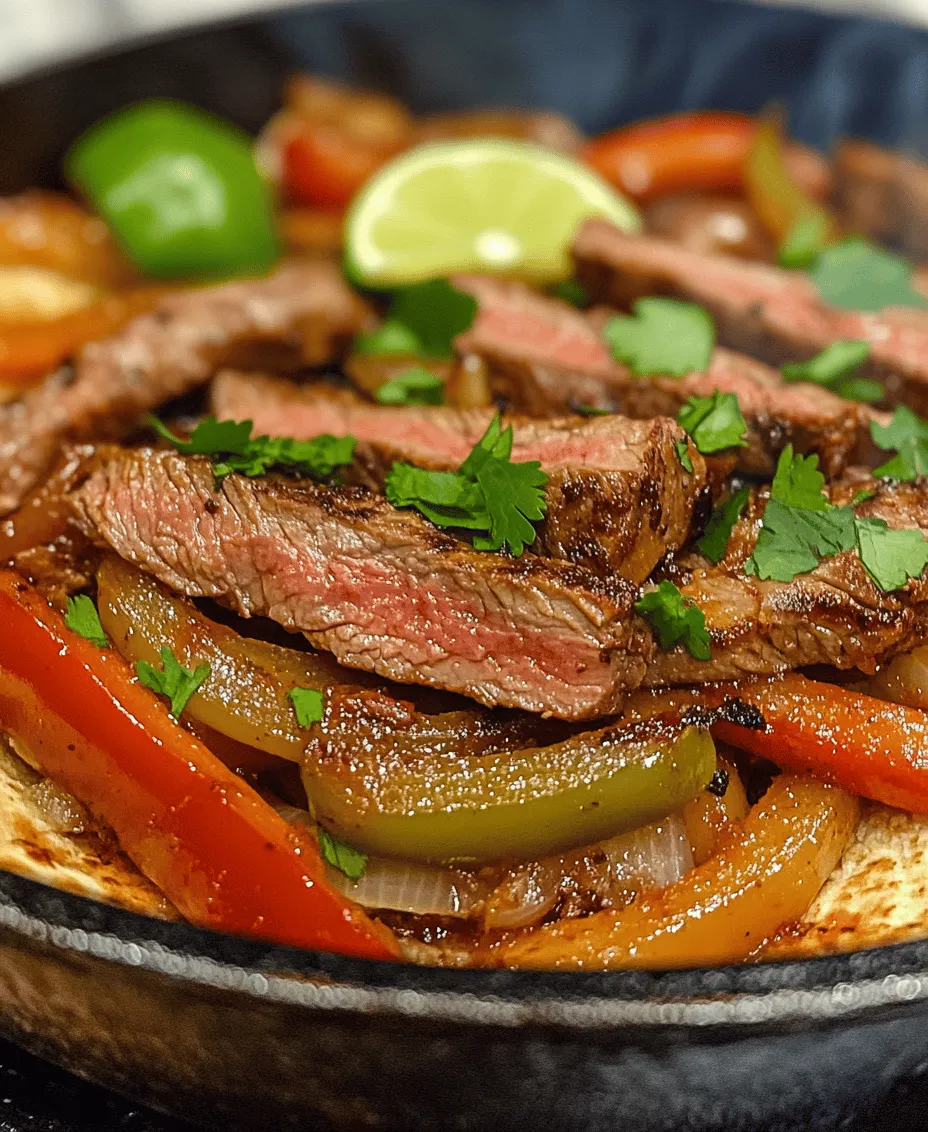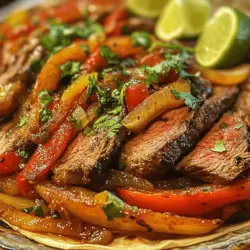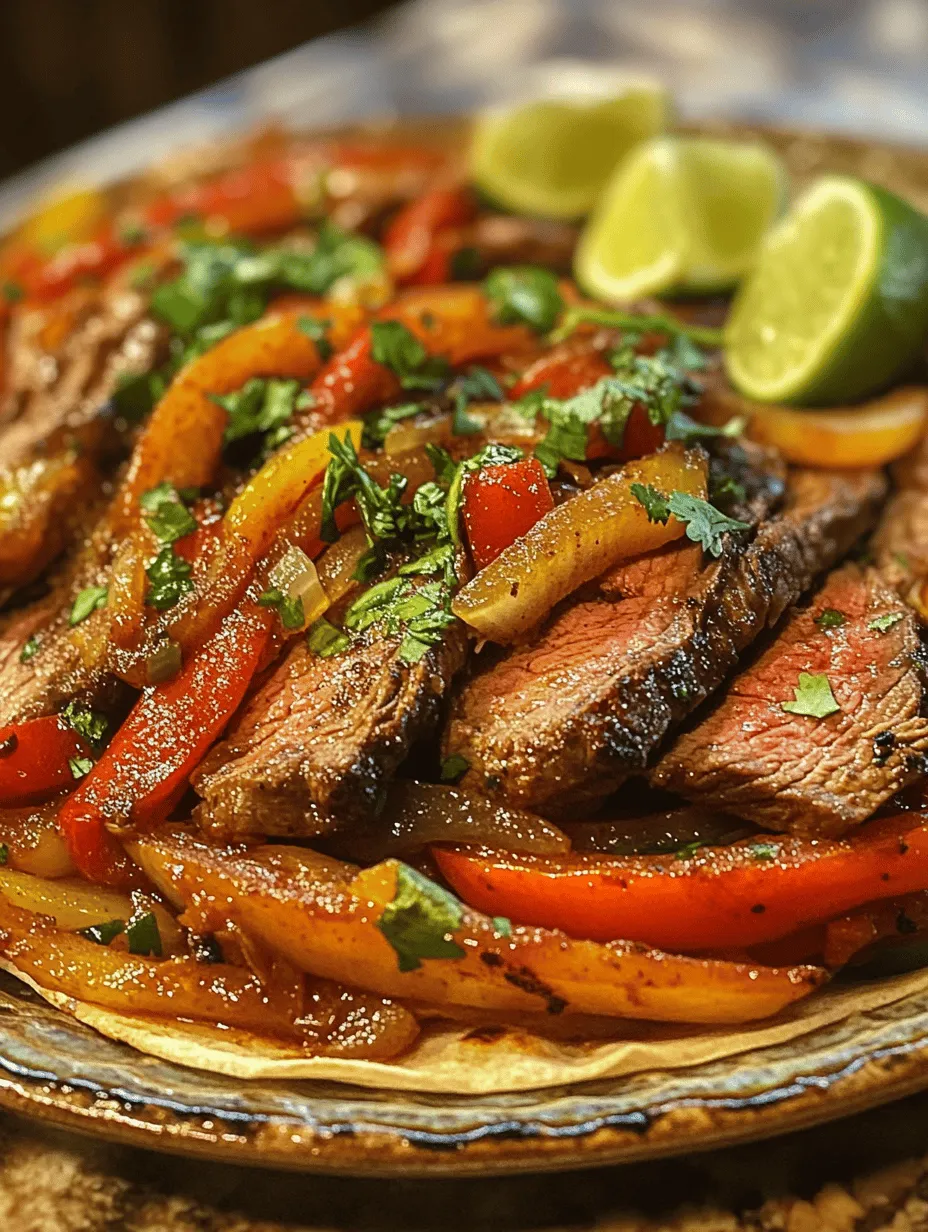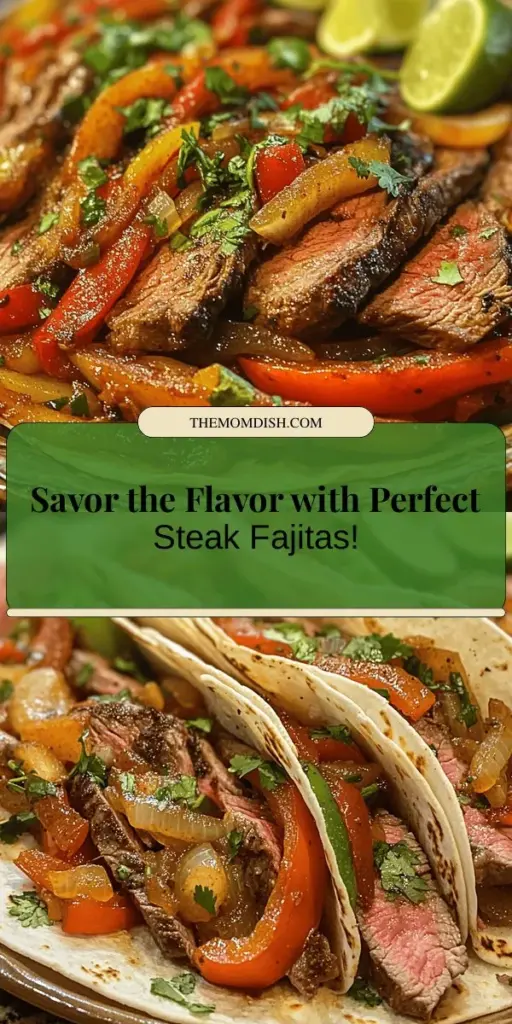Introduction
Steak fajitas are more than just a meal; they are an experience. This vibrant, sizzling dish has captured the hearts and taste buds of food lovers around the world. Originating from the rich tapestry of Mexican cuisine, steak fajitas are celebrated for their bold flavors, colorful presentation, and the exciting communal experience they offer. Whether served at a festive gathering or a cozy family dinner, steak fajitas bring people together, making every bite a moment worth savoring.
The appeal of steak fajitas lies in their perfect balance of flavors and textures. Mouthwatering strips of marinated flank steak are cooked to perfection, paired with vibrant, sautéed bell peppers and onions. All of this is enveloped in warm, soft tortillas, creating a delightful harmony that excites the palate. Topped off with fresh garnishes like cilantro and lime, this dish is not only delicious but also visually appealing, making it a favorite for both casual and celebratory occasions.
The Origins of Fajitas
To truly appreciate steak fajitas, it’s essential to understand their origins. The term “fajita” is derived from the Spanish word “faja,” meaning “strip” or “belt,” which refers to the thin strips of meat traditionally used in the dish. Fajitas were born in the 1930s in the ranchlands of South Texas, where Mexican cowboys, known as “vaqueros,” would grill skirt steak—an inexpensive cut of meat—over an open flame. This cooking method not only made the most of tougher cuts but also infused the meat with a smoky flavor.
Over the decades, fajitas evolved from a humble ranch meal to a staple in Tex-Mex cuisine, gaining popularity across the United States. Today, steak fajitas are often made with flank steak, which offers a more tender and flavorful alternative. The dish has also transcended its traditional roots, with modern interpretations featuring various marinades, spices, and toppings that reflect regional preferences and personal tastes. As fajitas grow in popularity, they have become a symbol of celebration, often served at birthdays, family reunions, and casual get-togethers.
Understanding the Key Ingredients
Creating the perfect steak fajitas starts with understanding the key ingredients that contribute to this flavorful dish. Each component plays a vital role, ensuring that every bite is a delightful explosion of taste and texture. Here’s a closer look at the essential ingredients that make steak fajitas so special:
Flank Steak
Flank steak is the star of the show when it comes to steak fajitas. This cut of meat is lean, with a rich, beefy flavor that pairs beautifully with the spices and vegetables. Its long, flat shape makes it ideal for slicing into thin strips, which is essential for fajitas. When cooked properly, flank steak becomes tender and juicy, making it a favorite among meat lovers. It’s important to slice the steak against the grain to enhance its tenderness, ensuring a satisfying bite every time.
Olive Oil
Olive oil is another key player in our fajita recipe, serving multiple purposes. Not only does it help in marinating the steak, enhancing its flavor and moisture, but it also plays a crucial role in cooking the vegetables. Olive oil is packed with health benefits, including heart-healthy monounsaturated fats and antioxidants. Its light flavor allows the spices and other ingredients to shine while providing a non-stick surface for cooking.
Spices
The spices used in steak fajitas are what elevate the dish from ordinary to extraordinary. A blend of chili powder, cumin, garlic powder, onion powder, and smoked paprika creates a complex flavor profile that is both bold and aromatic:
– Chili Powder: Adds heat and depth to the dish, with a flavor that can range from mild to spicy depending on the blend.
– Cumin: Offers a warm, earthy flavor that complements the beef and enhances the overall spiciness.
– Garlic Powder: Provides a savory note, intensifying the meat’s flavor and adding aromatic richness.
– Onion Powder: Contributes sweetness and depth, rounding out the spice profile.
– Smoked Paprika: Adds a subtle smokiness that mimics the flavor achieved by grilling, enhancing the overall taste experience.
Vegetables
Bell peppers and onions are not just colorful additions to steak fajitas; they contribute essential nutritional benefits and flavor contributions. Bell peppers come in various colors—red, green, yellow, and orange—each bringing a slightly different sweetness and crunch to the dish. They are rich in vitamins A and C, making them a healthy addition. Onions, which can be sautéed until caramelized, add a sweet and savory element that balances the richness of the steak.
Tortillas
No steak fajita is complete without the perfect tortillas. Flour tortillas are the traditional choice, known for their soft and pliable texture, making them ideal for wrapping around the hearty filling. Corn tortillas are also a popular option, offering a more authentic taste and a slightly firmer texture. The choice of tortilla can dramatically impact the overall experience, so opt for fresh, high-quality tortillas to elevate your fajitas.
Garnishes
The final touch to your sizzling steak fajitas comes from garnishes. Fresh cilantro brings a bright, herbaceous note that cuts through the richness of the meat. A squeeze of lime adds acidity and brightness, enhancing the flavors of the dish. Additionally, serving fajitas with salsa and sour cream offers a creamy contrast that complements the spices beautifully. These garnishes not only enhance the flavors but also add a pop of color to your plate, making the dish visually appealing.
Marinating the Steak: The Secret to Flavor
One of the secrets to achieving tender, flavorful steak fajitas lies in the marination process. Marinating the meat not only infuses it with the robust flavors of the spices but also helps to break down the muscle fibers, resulting in a more tender bite. Here’s a step-by-step guide to marinating your flank steak:
1. Prepare the Marinade: In a bowl, combine olive oil, lime juice, chili powder, cumin, garlic powder, onion powder, and smoked paprika. Whisk together until well-blended.
2. Add the Steak: Place the flank steak in a resealable plastic bag or shallow dish. Pour the marinade over the meat, ensuring that it is evenly coated.
3. Seal and Refrigerate: If using a bag, seal it tightly, removing as much air as possible. If using a dish, cover it with plastic wrap. Refrigerate for at least 30 minutes, but ideally for 2 to 4 hours to allow the flavors to penetrate deeply. For best results, marinating overnight is recommended.
4. Remove and Rest: After marinating, remove the steak from the fridge and let it come to room temperature for about 15-20 minutes before cooking. This step ensures even cooking.
Marinating the steak is crucial for maximizing flavor and tenderness, making it one of the most important steps in preparing your sizzling steak fajitas.
Preparing the Vegetables: Techniques for Perfect Texture
To complement the flavorful steak, the vegetables must be prepared with care. The goal is to achieve a perfect texture—crispy yet tender—while preserving their vibrant colors. Here are some essential techniques for preparing the bell peppers and onions for your fajitas:
1. Slice Uniformly: Cut the bell peppers and onions into thin, uniform strips. This ensures even cooking and allows them to blend seamlessly with the steak. Aim for about 1/4-inch strips to maximize surface area and caramelization.
2. Heat the Pan: Use a large skillet or cast-iron pan over medium-high heat. Allow the pan to heat thoroughly before adding oil. A hot pan is essential for achieving a good sear on the vegetables, which enhances their natural sweetness.
3. Add Olive Oil: Once the pan is hot, add a splash of olive oil, swirling it to coat the bottom. This will help prevent sticking and promote even cooking.
4. Sauté in Batches: To avoid overcrowding the pan, sauté the vegetables in batches. Start with the onions, cooking them for a couple of minutes until they begin to soften and turn translucent. Then, add the bell peppers and continue to sauté until they are tender but still slightly crisp. This usually takes about 5-7 minutes.
5. Season and Combine: Season the vegetables with a pinch of salt and pepper to enhance their natural flavors. Once cooked, remove them from the pan and set aside until ready to assemble your fajitas.
By following these techniques, you’ll achieve perfectly cooked vegetables that add both flavor and texture to your sizzling steak fajitas, elevating the overall dish to new heights.
In the next part of this article, we will dive into the cooking process for the steak, how to assemble the fajitas, and some expert tips for serving them to ensure an unforgettable meal. Stay tuned!

Best Practices for Slicing Vegetables for Fajitas
When it comes to preparing sizzling steak fajitas, the way you slice your vegetables can significantly enhance both their flavor and texture. Opt for a mix of bell peppers—red, yellow, and green—for a vibrant presentation and a range of flavors. Here are some best practices for slicing:
1. Uniform Size: Aim for thin, uniform strips (around 1/4 inch thick). This ensures the vegetables cook evenly, allowing them to achieve that perfect tenderness without becoming overly soft.
2. Angle Slicing: Cut your bell peppers and onions at an angle (also known as bias cutting). This technique not only adds visual appeal but also increases the surface area for caramelization, enhancing the flavor.
3. Prep Ahead: To streamline your cooking process, slice your vegetables ahead of time and store them in airtight containers in the fridge. This makes it easier to grab them when you’re ready to cook.
4. Freshness Matters: Use fresh vegetables for the best taste. Avoid pre-cut produce that may have lost some of its flavor and nutrients.
Cooking Methods: Sautéing vs. Grilling and Their Effects on Flavor
Two popular cooking methods for fajitas are sautéing and grilling, and each imparts a unique flavor profile to the dish.
– Sautéing: When you sauté your vegetables in a skillet, you have the opportunity to control the heat and timing more precisely. This method allows for even cooking and the ability to add other ingredients like garlic or spices directly into the pan, enhancing the overall flavor. Use a bit of oil to promote caramelization, which adds depth to the vegetables.
– Grilling: Grilling vegetables brings out a smoky flavor that cannot be replicated on the stovetop. The high heat of the grill chars the vegetables, creating a delicious contrast to the sweetness of the bell peppers and the sharpness of the onions. Plus, the grill marks add an appealing visual element to your dish.
Timing the Vegetable Cooking Process to Achieve Desired Tenderness
Achieving the perfect tenderness for your fajita vegetables involves careful timing:
1. Start with Onions: Begin by adding your sliced onions to the hot skillet or grill first. They take a bit longer to soften up—about 3-5 minutes depending on the heat.
2. Add Bell Peppers: Once the onions are starting to become translucent, add the bell peppers. Cook for an additional 4-6 minutes, tossing occasionally, until they are tender yet still have a slight crunch.
3. Don’t Overcook: Remember, you want the vegetables to retain some texture. Overcooked fajita veggies can become mushy and lose their vibrant color.
Cooking the Flank Steak to Perfection
Flank steak is an excellent choice for fajitas, known for its rich flavor and relatively quick cooking time. Here are the techniques and steps to ensure your steak is cooked to perfection:
Techniques for Cooking Flank Steak: Skillet vs. Grill
– Skillet Cooking: Using a cast-iron skillet is a fantastic method for achieving a beautifully seared flank steak. Preheat the skillet over medium-high heat and add a small amount of oil. Once the oil is shimmering, lay the steak down and sear it for about 4-5 minutes per side, depending on thickness.
– Grilling: If you prefer grilling, preheat your grill to high heat. Season the steak with salt, pepper, and any additional spices you desire. Grill the steak for about 4-6 minutes per side, ensuring you achieve those beautiful grill marks.
Detailed Instructions on Achieving Different Levels of Doneness
To ensure your flank steak meets your preferred level of doneness, it’s essential to use a meat thermometer:
– Rare (125°F): Cook for about 3-4 minutes per side.
– Medium Rare (135°F): Cook for about 4-5 minutes per side.
– Medium (145°F): Cook for about 5-6 minutes per side.
– Medium Well (150°F): Cook for about 6-7 minutes per side.
– Well Done (160°F and above): Cook for an additional minute or two per side.
Importance of Resting the Steak Before Slicing for Juiciness
After cooking, let your flank steak rest for at least 5-10 minutes before slicing. This resting period allows the juices to redistribute throughout the meat, ensuring every bite is juicy and flavorful. If you slice too soon, the juices will run out, leaving you with a drier steak.
Assembling the Sizzling Fajitas
Once your steak and vegetables are ready, it’s time to assemble your fajitas. Here’s a step-by-step guide to creating the perfect sizzling steak fajitas:
1. Slice the Steak: After resting, slice the flank steak against the grain into thin strips. This technique helps keep the meat tender.
2. Warm the Tortillas: To prevent tearing, warm your tortillas in a dry skillet over medium heat for about 30 seconds on each side, or wrap them in foil and place them in a preheated oven at 350°F for about 10 minutes.
3. Layering: Start with a warm tortilla as your base. Add a generous portion of the sautéed or grilled vegetables, followed by slices of flank steak.
4. Toppings: Elevate your fajitas with toppings like freshly chopped cilantro, diced avocado, sour cream, guacamole, or salsa. A squeeze of lime juice adds a refreshing zesty kick.
5. Serve Hot: Serve your fajitas immediately while they are still sizzling on the skillet or grill. Present them on a platter with extra toppings on the side for a festive touch.
Creative Serving Suggestions for a Visually Appealing Presentation
To make your fajitas visually appealing, consider serving them on a large wooden board or a colorful platter. Arrange the sliced steak and vegetables in a way that showcases their vibrant colors. Garnish with fresh herbs and lime wedges. You can also include small bowls of toppings, allowing your guests to customize their fajitas according to their preferences.
Exploring Variations of Steak Fajitas
While traditional steak fajitas are delicious, there are numerous creative variations you can try to keep your meals exciting:
1. Alternative Proteins: Swap flank steak for chicken, shrimp, or even tofu for a vegetarian option. Each protein will have its unique flavor and texture, allowing you to explore different fajita styles.
2. Different Spice Blends and Marinades: Experiment with various spice blends, such as taco seasoning, cumin, or chipotle powder, to infuse different flavors into your fajitas. Marinating your protein overnight with lime juice, garlic, and spices can also enhance the taste.
3. International Twists: Explore international variations by incorporating different ingredients or cooking styles. For example, Korean-inspired fajitas might include bulgogi beef, while Mediterranean fajitas could feature marinated lamb with tzatziki sauce.
Pairing Suggestions for Sizzling Fajitas
To elevate your dining experience, consider pairing your sizzling steak fajitas with complementary side dishes and beverages:
Recommended Side Dishes
– Rice: Cilantro lime rice or Spanish rice can enhance the meal and provide a hearty base.
– Beans: Refried beans or black beans seasoned with spices add fiber and protein.
– Salads: A fresh salad with avocado, tomatoes, and a light vinaigrette can balance the richness of the fajitas.
Beverage Pairings
– Wines: A fruity red wine like Zinfandel or a crisp white wine like Sauvignon Blanc can complement the flavors of the fajitas nicely.
– Beers: Light lagers or pale ales work well, as their refreshing qualities pair beautifully with the spices in the fajitas.
– Non-Alcoholic Drinks: Fresh lemonade or a fruity iced tea can provide a refreshing contrast to the savory flavors of the meal.
Conclusion
Sizzling steak fajitas are a versatile and delicious dish that can easily be customized to suit any palate. Whether you prefer the classic version or are inspired to try a creative twist, this recipe is sure to impress family and friends alike. The process of cooking and sharing meals brings joy and connection to our lives, making these fajitas not just a meal but an experience.
So, gather your ingredients, fire up the skillet or grill, and dive into this culinary adventure. You’ll not only enjoy a satisfying dish but also create lasting memories around the dinner table. Happy cooking!



